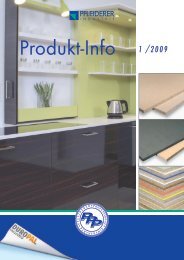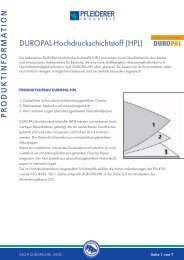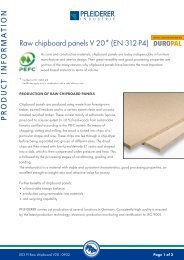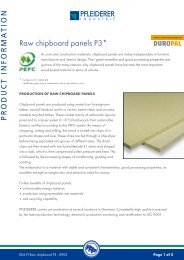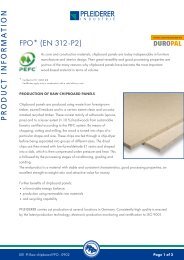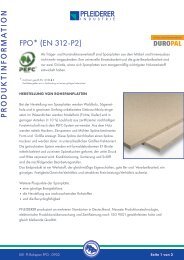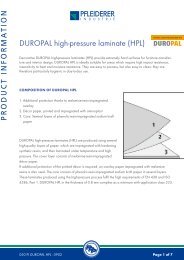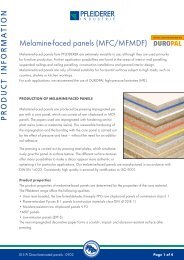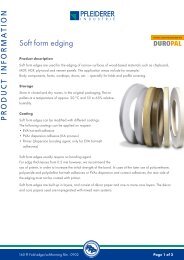Processing and working instructions HPL and HPL elements PR ...
Processing and working instructions HPL and HPL elements PR ...
Processing and working instructions HPL and HPL elements PR ...
Create successful ePaper yourself
Turn your PDF publications into a flip-book with our unique Google optimized e-Paper software.
<strong>PR</strong>ODUCT INFORMATION<br />
8.3 <strong>Processing</strong><br />
8.3.1 Cutting<br />
• For cutting, we recommend the use of carbide- or diamond-tipped saw blades, as also used for the<br />
processing of DUROPAL <strong>HPL</strong>.<br />
• With DUROPAL <strong>HPL</strong>-Solid, a lower feed speed should be used than for DUROPAL <strong>HPL</strong> <strong>elements</strong>.<br />
• For compact laminates with décor on both sides, damage to the lower décor layer can be effectively<br />
avoided by changing the exit angle. This can be achieved by varying the height setting of the saw blade.<br />
• Good results can also be achieved by placing plywood, hard fibre panels or DUROPAL <strong>HPL</strong> under the<br />
panels.<br />
• Optimum cut quality of the lower edge can be achieved by using a pre-scoring device.<br />
8.3.2 routing <strong>and</strong> drilling<br />
• For routing, we recommend carbide- or diamond-tipped routers with high rotational accuracy, in order to<br />
minimise chatter marks. The use of special router heads has proven useful for processing large quantities<br />
of panels.<br />
• Due to the high cutting pressure, secure tool guides <strong>and</strong> fences are essential.<br />
• Cutting marks on the milling surface are unavoidable. These can be reduced by using a mechanical<br />
router <strong>and</strong> by milling in the same direction. Any remaining marks can then be removed by s<strong>and</strong>ing <strong>and</strong><br />
polishing.<br />
• Further improvements in the appearance of the edge can be achieved by treatment with silicon-free<br />
furniture oils.<br />
• Projecting corners <strong>and</strong> edges should be chamfered in order to avoid the risk of injury.<br />
• Drills used for plastics are most suitable for drilling.<br />
• Splintering of the DUROPAL <strong>HPL</strong>-Solid on the outlet side can be avoided by <strong>working</strong> on a firm surface<br />
<strong>and</strong> gradually reducing the feed speed.<br />
• Drills with a tip angle of 50-60° should preferably be used for through-holes.<br />
• Ensure when centre-drilling that a minimum of panel material remains.<br />
• This requires a minimum remaining thickness for blind holes of at least 1.5 mm, <strong>and</strong> at least 3 mm<br />
for holes parallel to the surface.<br />
• In all DUROPAL <strong>HPL</strong>-Solid, threads can be cut <strong>and</strong> self-tapping screws used without any problems.<br />
099 PI <strong>Processing</strong> <strong>and</strong> <strong>working</strong> <strong>instructions</strong> Page 26 of 34



